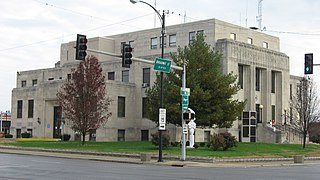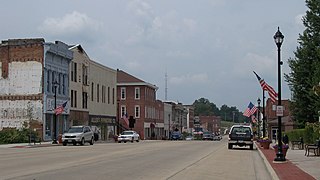
Clinton County is located in the U.S. state of Illinois. At the 2020 census, the population was 36,899. Its county seat is Carlyle.

Clay County is a county in the southeastern portion of the U.S. state of Illinois. As of the 2020 United States Census, the population was 13,288. Since 1842, its county seat has been Louisville, in the center of the county's area.

Marion County is a county located in the U.S. state of Illinois. According to the 2020 census, it had a population of 37,729. Its county seat is Salem.

Jefferson County is a county located in the southern part of the U.S. state of Illinois. According to the 2020 census, it has a population of 37,113. The county seat is Mount Vernon.

Fayette County is a county located in the U.S. state of Illinois. As of the 2020 census, the population was 21,488. Its county seat is Vandalia, the site of the Vandalia State House State Historic Site. Ramsey Lake State Recreation Area is located in the northwestern part of this county.

Carlyle is a city and county seat of Clinton County, Illinois, United States. The population was 3,253 at the 2020 census.

Centralia is a city in Clinton, Jefferson, Marion, and Washington counties in the U.S. state of Illinois with the largest portion in Marion County. The city is the largest in three of the counties; Clinton, Marion, and Washington, but is not a county seat of any of them. The population was 12,182 as of the 2020 census, down from 13,032 in 2010.

Vandalia is a city in and the county seat of Fayette County, Illinois, United States. At the 2020 Census, the population was 7,458. Vandalia is on the Kaskaskia River, and 60 miles (97 km) northeast of the St. Louis area. The city served as the state capital of Illinois from 1819 until 1839, when the seat of state government moved closer to the center of the state in Springfield. In the early 19th century, Vandalia was the western terminus of the National Road from the East Coast. Since 1933, the Vandalia State House State Historic Site has sought to preserve and interpret the State House building and grounds, originally constructed in 1836.

Mount Vernon is a city in and the county seat of Jefferson County, Illinois, United States. The population was 14,600 at the 2020 census. Mount Vernon is the principal city of the Mount Vernon Micropolitan Statistical Area, which includes all of Jefferson and Hamilton counties.

Central City is a village in Marion County, Illinois, United States. The population was 1,098 at the 2020 census.

Junction City is a village in Marion County, Illinois, United States. The population was 527 at the 2020 census.

Kell is a village in Marion County, Illinois, United States. The population was 173 at the 2020 census, down from 219 in 2010.

Patoka is a village in Marion County, Illinois, United States. The population was 525 at the 2020 census.

Sandoval is a village in Marion County, Illinois, United States. The population was 1,157 at the 2020 census.

Vernon is a village in Marion County, Illinois, United States. The population was 103 at the 2020 census.

Fillmore is a village in Montgomery County, Illinois, United States. The population was 305 at the 2020 census.

Taylor Springs is a village in Montgomery County, Illinois, United States. The population was 724 at the 2020 census.
Goshen Road was an early road that ran from Old Shawneetown, Illinois, on the Ohio River, northwest to the Goshen Settlement, near Glen Carbon, Illinois, near the Mississippi River. In the early 19th century, this was the main east/west road in Illinois.

The Columbia metropolitan area is the region centered around the City of Columbia in the U.S. state of Missouri. Located in Mid-Missouri, it consists of five counties: Boone, Audrain, Randolph, Cooper, and Howard. The population was estimated at 256,640 in 2017, making it the 4th largest metropolitan area in Missouri. Columbia is home to the University of Missouri, and is Missouri's fourth most-populous and fastest growing city, with an estimated 121,717 residents as of 2017. Other significant cities in the area include Moberly, Mexico, Boonville, Vandalia, Centralia, and Fayette.

Vandalia Township is one of twenty townships in Fayette County, Illinois, USA. As of the 2020 census, its population was 6,364 and it contained 3,069 housing units.




















